Possibilities of Using Geopolymers in Welding Processes and Protection against High Temperatures
Abstract
:1. Introduction
2. Materials and Methods
3. Results
4. Discussion
5. Conclusions
- Geopolymers have a very high thermal resistance and do not degrade at temperatures above 1000 °C;
- They can be an interesting alternative to the current materials used for thermite welding molds;
- Several additional studies that can completely confirm the possibility of producing thermite welding molds from geopolymers should be carried out. The problems that were observed when trying to weld rails using geopolymer molds were due to the channels in the molds being too small. The reason for this was that a two-part mold was used to make the geopolymer material and the target geopolymer mold had to be ground and glued. As a result of these procedures, in the final mold produced, the cross-sections of the holes were altered. It is necessary to make a professional casting mold for further research.
Author Contributions
Funding
Institutional Review Board Statement
Informed Consent Statement
Data Availability Statement
Acknowledgments
Conflicts of Interest
References
- Davidovits, J. Geopolymer Chemistry and Applications, 4th ed.; Geopolymere Institut: Saint-Quentin, France, 2008. [Google Scholar]
- Provis, J.L.; van Deventer, J.S.J. Geopolymers: Structure, Processing, Properties and Industrial Applications; A volume in Woodhead Publishing Series in Civil and Structural Engineering; Woodhead Publishing: Cambridge, UK, 2009. [Google Scholar]
- Davidovits, J. 30 Years of Successes and Failures in Geopolymer Applications. Market Trends and Potential Breakthroughs. In Proceedings of the Geopolymer 2002 Conference, Melbourne, Australia, 28–29 October 2002. [Google Scholar]
- Chindaprasirt, P.; Lao-un, J.; Zaetang, Y.; Wongkvanklom, A.; Phoo-ngernkham, T.; Wongsa, A.; Sata, V. Thermal insulating and fire resistance performances of geopolymer mortar containing auto glass waste as fine aggregate. J. Build. Eng. 2022, 60, 105178. [Google Scholar] [CrossRef]
- Akarken, G.; Cengiz, U. Fabrication and characterization of metakaolin-based fiber reinforced fire resistant geopolymer. Appl. Clay Sci. 2023, 232, 106786. [Google Scholar] [CrossRef]
- Wang, J.; Chen, X.; Li, C.; Zhou, Z.; Du, P.; Zhang, X. Evaluating the effect of kaliophilite on the fire resistance of geopolymer concrete. J. Build. Eng. 2023, 75, 106975. [Google Scholar] [CrossRef]
- Kočí, V.; Černý, R. Directly foamed geopolymers: A review of recent studies. Cem. Concr. Compos. 2022, 130, 104530. [Google Scholar] [CrossRef]
- Zhang, Z.; Provis, J.L.; Reid, A.; Wang, H. Mechanical, thermal insulation, thermal resistance and acoustic absorption properties of geopolymer foam concrete. Cem. Concr. Compos. 2015, 62, 97–105. [Google Scholar] [CrossRef]
- Skvara, F.; Sulc, R.; Tisler, Z.; Skricik, P.; Smilauer, V.; Zlamalova Cilova, Z. Preparation and properties of fly as-based geopolymer foams. Ceram. Silik. 2014, 58, 188–197. [Google Scholar]
- van Schaijk, E. Intumescent Coatings for Advanced Passive Fire Protection. Hempacore Passive Fire Protection, Hempel Group, Danemark. 2014. Available online: http://www.nace-jubail.org/Meetings/HEMPACORE%20ONE_SSPC_April2014.pdf (accessed on 2 August 2023).
- Vickers, L.; van Riessen, A.; Rickard, W.D.A. Fire-Resistant Geopolymers: Role of Fibres and Fillers to Enhance Thermal Properties; Springer Briefs in Materials; Springer: Singapore, 2014. [Google Scholar]
- Łach, M.; Mierzwiński, D.; Korniejenko, K.; Mikuła, J. Geopolymer foam as a passive fire protection. In Proceedings of the MATEC Web of Conferences, Fire and Environmental Safety Engineering, Lviv, Ukraine, 7–8 November 2018; Volume 247, p. 00031. [Google Scholar] [CrossRef]
- Łach, M.; Mierzwiński, D.; Korniejenko, K.; Stanek, A.; Mikuła, J. The behaviour of alkali activated materials based on calcium clay at elevated temperatures. In Proceedings of the MATEC Web of Conferences, Fire and Environmental Safety Engineering, Lviv, Ukraine, 7–8 November 2018; Volume 247, p. 00054. [Google Scholar] [CrossRef]
- Buczkowska, K.; Le, C.H.; Louda, P.; Szczypiński, M.; Bakalova, T.; Pacyniak, T.; Prałat, K. The fabrication of geopolymer foam composites incorporating coke dust waste. Processes 2020, 8, 1052. [Google Scholar] [CrossRef]
- Le, C.H.; Louda, P.; Buczkowska, K.E.; Dufkova, I. Investigation on Flexural Behavior of Geopolymer-Based Carbon Textile/Basalt Fiber Hybrid Composite. Polymers 2021, 13, 751. [Google Scholar] [CrossRef]
- Korniejenko, K.; Łach, M.; Mikuła, J. The influence of short coir, glass and carbon fibers on the properties of composites with geopolymer matrix. Materials 2021, 14, 4599. [Google Scholar] [CrossRef]
- Le, V.S.; Louda, P.; Tran, H.N.; Nguyen, P.D.; Bakalova, T.; Buczkowska, K.E.; Dufkova, I. Study on Temperature-Dependent Properties and Fire Resistance of Metakaolin-Based Geopolymer Foams. Polymers 2020, 12, 2994. [Google Scholar] [CrossRef]
- Temuujin, J.; Minjigmaa, A.; Rickard, W.; Lee, M.; Williams, I.; Van Riessen, A. Fly ash based geopolymer thin coatings on metal substrates and its thermal evaluation. J. Hazard. Mater. 2010, 180, 748–752. [Google Scholar] [CrossRef]
- Yong, S.L.; Feng, D.W.; Lukey, G.C.; Van Deventer, J.S.J. Chemical characterisation of the steel geopolymeric gel interface. Colloids Surf. A Physicochem. Eng. Asp. 2007, 302, 411–423. [Google Scholar] [CrossRef]
- Balaguru, P.N.; Nazier, M.; Arafa, M. Field Implementation of Geopolymer Coatings; New Jersey Department of Transportation: Ewing Township, NJ, USA, 2008; Available online: https://cait.rutgers.edu/wp-content/uploads/2018/05/fhwa-nj-2002-011.pdf (accessed on 2 August 2023).
- Klimpel, A. Napawanie i Natryskiwanie Cieplne; WNT: Warszawa, Poland, 2000. [Google Scholar]
- Plewniak, J.; Służalec, A. Regeneracja Metodami Spawalniczymi; Wydawnictwo Politechniki Częstochowskiej: Częstochowa, Poland, 1992. [Google Scholar]
- Plaichum, S.; Kaewvilai, A.; Pantongsuk, T.; Chaysuwan, D.; Tippayasam, C. A Novel Ceramic Backing Strip from Metakaolin-Based Geopolymer with Gas Flow Holes for Welding Application. Key Eng. Mater. 2020, 856, 309–316. [Google Scholar] [CrossRef]
- Grzechowiak, W.; Wróblewski, P. Thermite Welding Methods "with Reduced Heating Time" for Joining Rails in High-Speed Railways; III National Scientific and Technical Conference Welding of Railroads and Materials, Workmanship, Acceptances: Warsaw-Bochnia, Poland, 2007; pp. 1–5. [Google Scholar]
- Kądziołka, A. Thermite Welding-Historical Overview, Changes, Progress; IV All-Poland Scientific and Technical Conference Welding of Railroads-Quality, Reliability, Safety: Bochnia, Poland, 2010; pp. 1–22. Available online: https://spawalnictwoszyn.pl/wp-content/uploads/2014/07/a_kadziolka.pdf (accessed on 2 August 2023).
- PKP Polskie Linie Kolejowe, S.A. Instrukcja Spawania Szyn Termitem ID-5. Available online: https://www.plk-sa.pl/files/public/user_upload/pdf/Akty_prawne_i_przepisy/Instrukcje/Podglad/Id-5.pdf (accessed on 2 August 2023).
- PN-EN 196-1:2016-07; Methods of Testing Cement—Part 1: Determination of Strength. Polish Committee for Standardization: Warsaw, Poland, 2016.
- ASTM C518-21; Standard Test Method for Steady-State Thermal Transmission Properties by Means of the Heat Flow Meter Apparatus. ASTM: West Conshohocken, PN, USA, 2021.
- ASTM C1784-20; Standard Test Method for Using a Heat Flow Meter Apparatus for Measuring Thermal Storage Properties of Phase Change Materials and Products. ASTM: West Conshohocken, PN, USA, 2020.
- PN-ISO 8301:1998; Thermal Insulation: Determination of Steady-State Thermal Resistance and Related Properties. Polish Committee for Standardization: Warsaw, Poland, 1998.
- JIS A1412-1:1999; Test Method for Thermal Resistance and Related Properties of Thermal Insulations—Guarded Hot Plate Apparatus. Japanese Standards Association: Tokyo, Japan, 1999.
- PN-EN 12667:2002; Thermal Performance of Building Materials and Products—Determination of Thermal Resistance by Means of Guarded Hot Plate and Heat Flow Meter Methods—Products of High and Medium Thermal Resistance. Polish Committee for Standardization: Warsaw, Poland, 2002.
- PN-EN 12664:2002; Thermal Performance of Building Materials and Products—Determination of Thermal Resistance by Means of Guarded Hot Plate and Heat Flow Meter Methods—Dry and Moist Products of Medium and Low Thermal Resistance. Polish Committee for Standardization: Warsaw, Poland, 2002.
- PN-EN 12390-3:2019-07; Testing of Concrete—Part 3: Compressive Strength of Test Specimens. Polish Committee for Standardization: Warsaw, Poland, 2019.
- PN-EN 12390-7:2013-03; Testing Hardened Concrete—Part 7: Density of Hardened Concrete. Polish Committee for Standardization: Warsaw, Poland, 2013.
- Sitarz, M.; Hager, I.; Kochanek, J. Effect of high temperature on mechanical properties of geopolymer mortar. In Proceedings of the MATEC Web of Conferences, Fire and Environmental Safety Engineering, Lviv, Ukraine, 7–8 November 2018; Volume 163, p. 06004. [Google Scholar] [CrossRef]
- PN-EN ISO 1716:2018-08; Tests of Reaction to Fire of Products—Determination of Gross Heat of Combustion (Calorific Value). Polish Committee for Standardization: Warsaw, Poland, 2018.
- PN-EN ISO 1182:2020-12; Tests of Reaction to Fire of Construction Products—Non-Combustibility Tests. Polish Committee for Standardization: Warsaw, Poland, 2020.
- Dhasindrakrishna, K.; Ramakrishnan, S.; Pasupathy, K.; Sanjayan, J. Synthesis and performance of intumescent alkali-activated rice husk ash for fire-resistant applications. J. Build. Eng. 2022, 51, 104281. [Google Scholar] [CrossRef]
- Łach, M.; Pławecka, K.; Bąk, A.; Lichocka, K.; Korniejenko, K.; Cheng, A.; Lin, W.T. Determination of the influence of hydraulic additives on the foaming process and stability of the produced geopolymer foams. Materials 2021, 14, 5090. [Google Scholar] [CrossRef] [PubMed]
- Ciemnicka, J.; Jaskulski, R.; Kubissa, W.; Prałat, K. Influence of selected micro additives content on thermal properties of gypsum. Archit. Civ. Eng. Env. 2019, 12, 69–79. [Google Scholar] [CrossRef]
- Heim, D.; Mrowiec, A.; Prałat, K. Analysis and interpretation of results of thermal conductivity obtained by the hot wire method. Exp. Tech. 2016, 40, 513–519. [Google Scholar] [CrossRef]
- Prałat, K. Research on thermal conductivity of the wood and analysis of results obtained by the hot wire method. Exp. Tech. 2016, 40, 973–980. [Google Scholar] [CrossRef]
- Robert, P.M.; Giannopoulou, I.P.; Savva, P.; Sakkas, K.M.; Petrou, M.F.; Nicolaides, D. New Eco-Friendly Inorganic Polymeric Materials for the Passive Fire Protection of Structures. In TMS 2023 152nd Annual Meeting& Exhibition Supplemental Proceedings, The Minerals, Metals & Materials Series; Springer Nature Switzerland: Cham, Switzerland, 2023; pp. 758–767. [Google Scholar] [CrossRef]
- Mares, J.; Mamon, F.; Jaskevic, M.; Novotny, J. Adhesion of Various Geopolymers Coatings on Metal Substrates. Manuf. Technol. 2023, 23, 81–87. [Google Scholar] [CrossRef]
- Shilar, F.A.; Ganachari, S.V.; Patil, V.B.; Bhojaraja, B.E.; Yunus Khan, T.M.; Almakayeel, N. A review of 3D printing of geopolymer composites for structural and functional applications. Constr. Build. Mater. 2023, 400, 132869. [Google Scholar] [CrossRef]
- Jamaludin, L.; Razak, R.A.; Abdullah, M.M.A.B.; Vizureanu, P.; Bras, A.; Imjai, T.; Sandu, A.V.; Abd Rahim, S.Z.; Yong, H.C. The Suitability of Photocatalyst Precursor Materials in Geopolymer Coating Applications: A Review. Coatings 2022, 12, 1348. [Google Scholar] [CrossRef]
- Teixeira Marvila, M.; Rangel Garcez de Azevedo, A.; Alexandre Tostes Linhares Júnior, J.; Maurício Fontes Vieir, C. Activated alkali cement based on blast furnace slag: Effect of curing type and concentration of Na20. J. Mater. Res. Technol. 2023, 23, 4551–4565. [Google Scholar] [CrossRef]
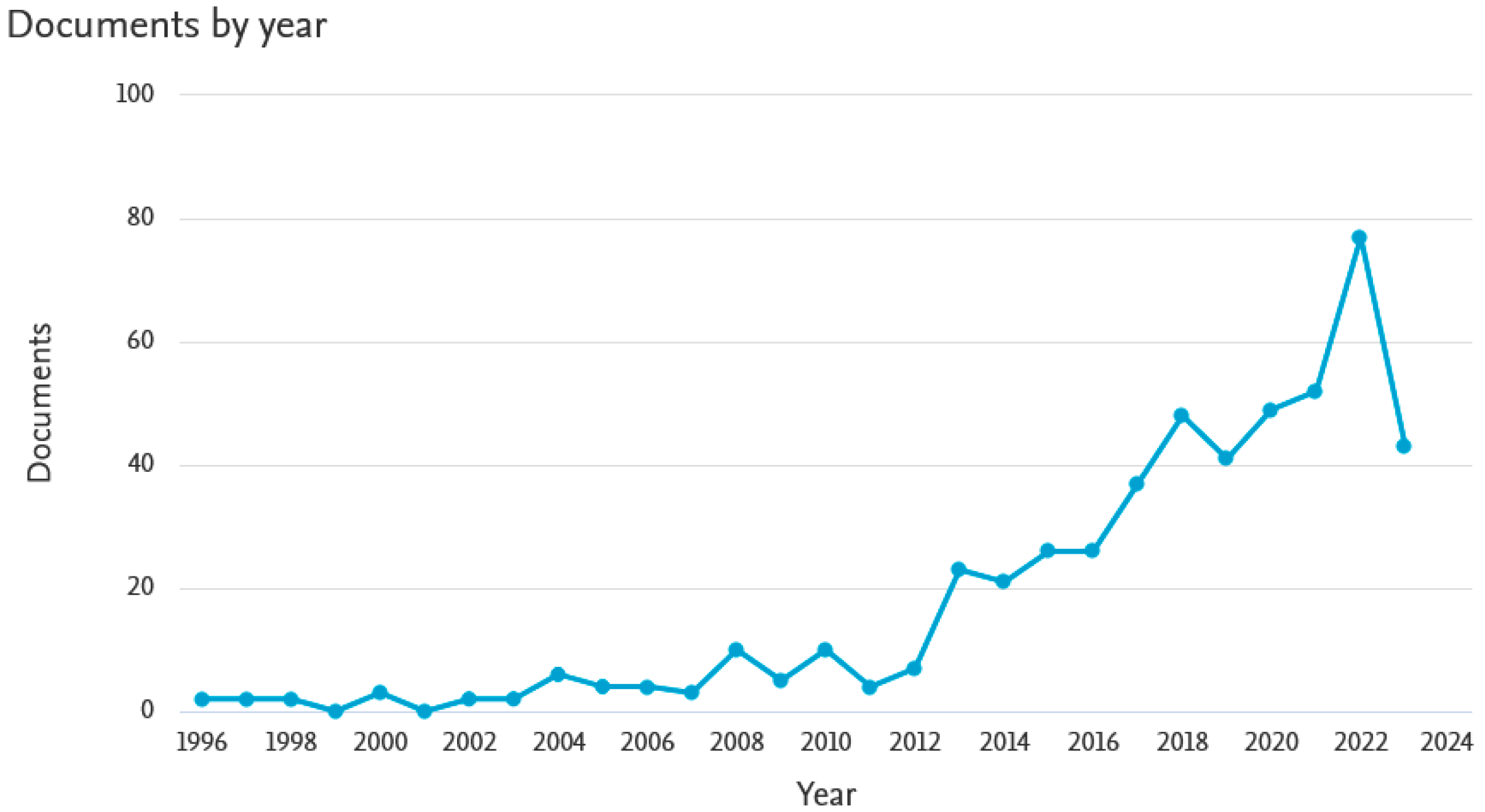
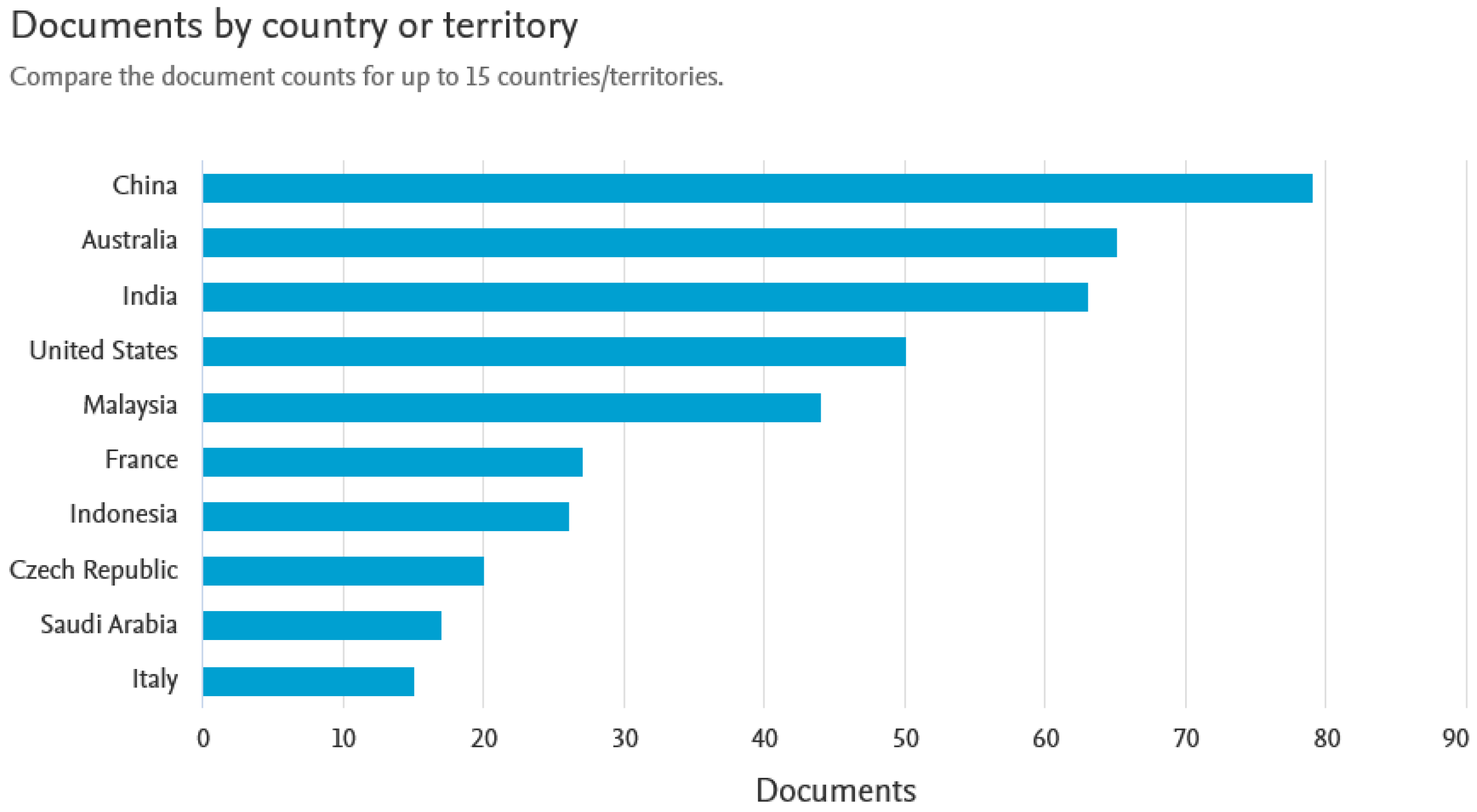
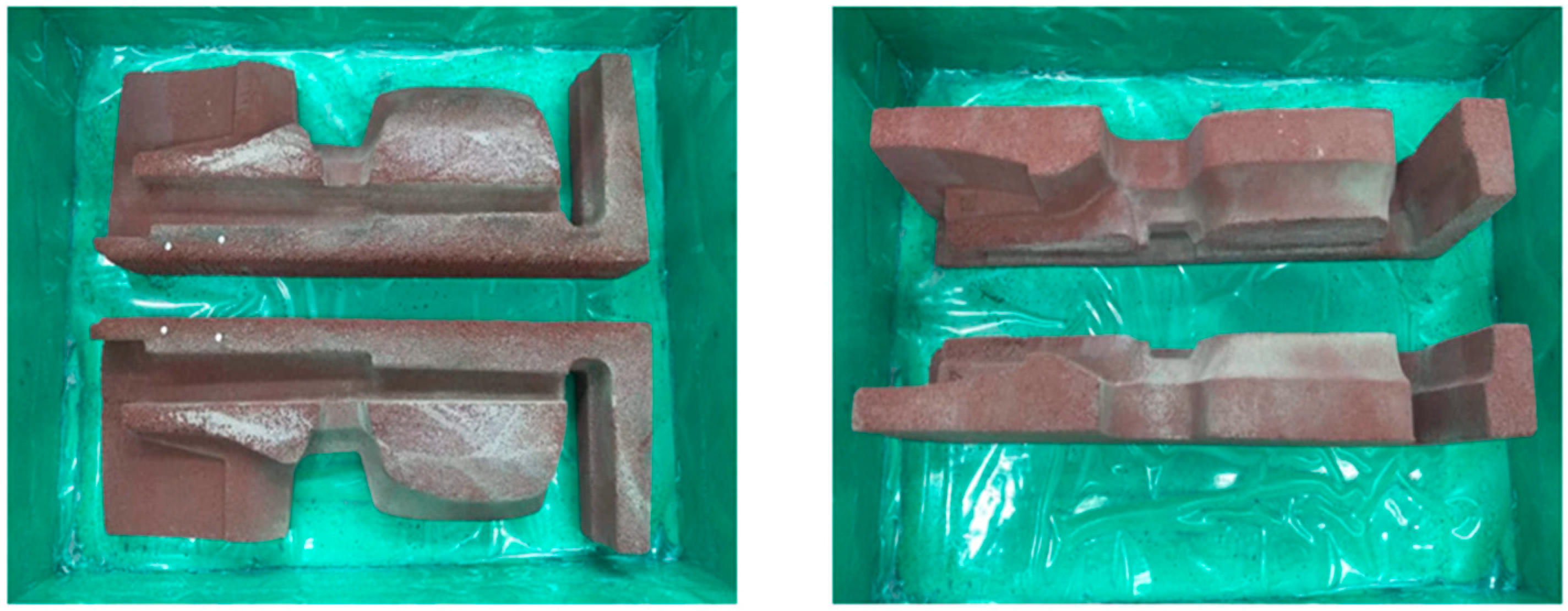

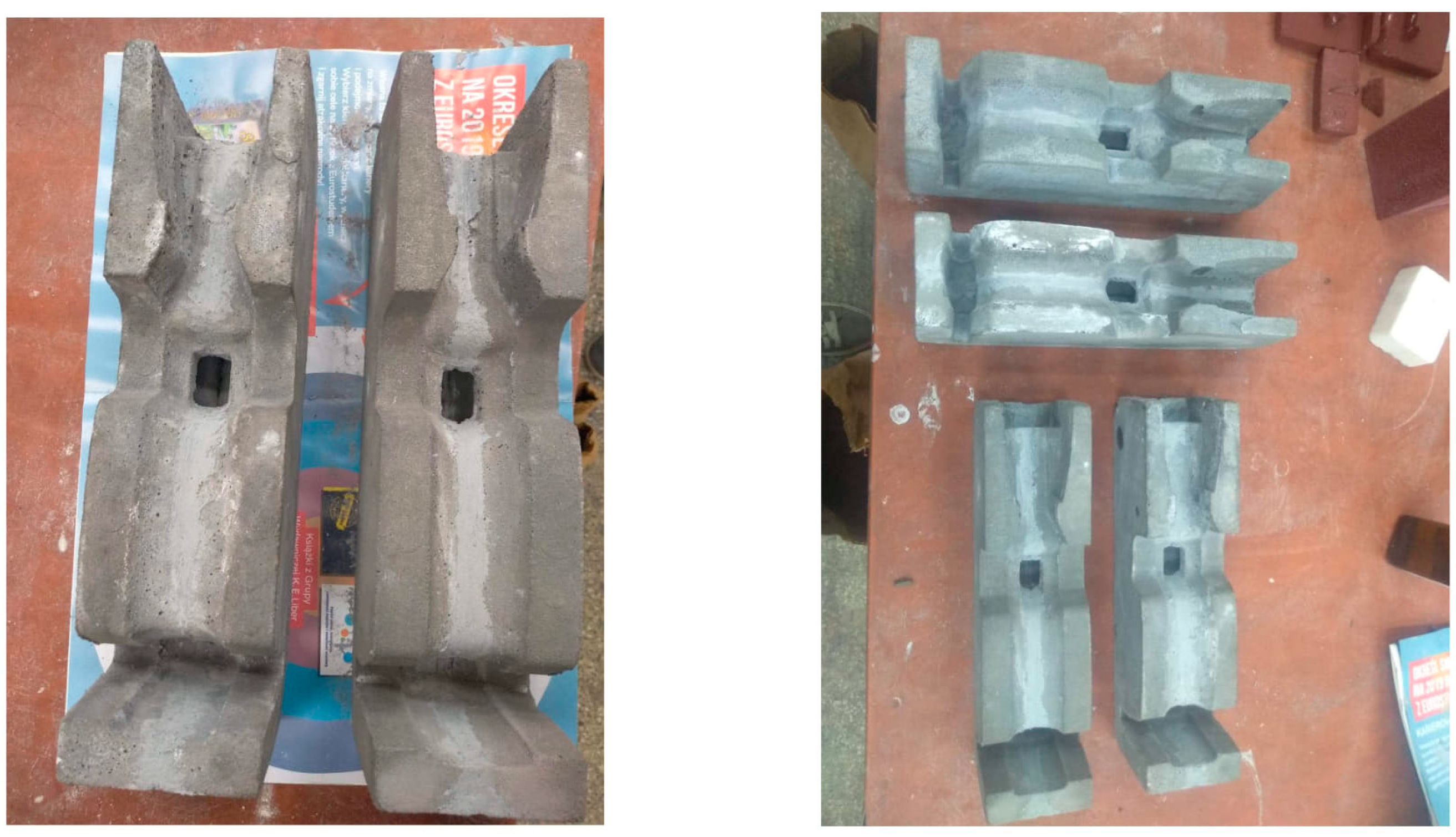

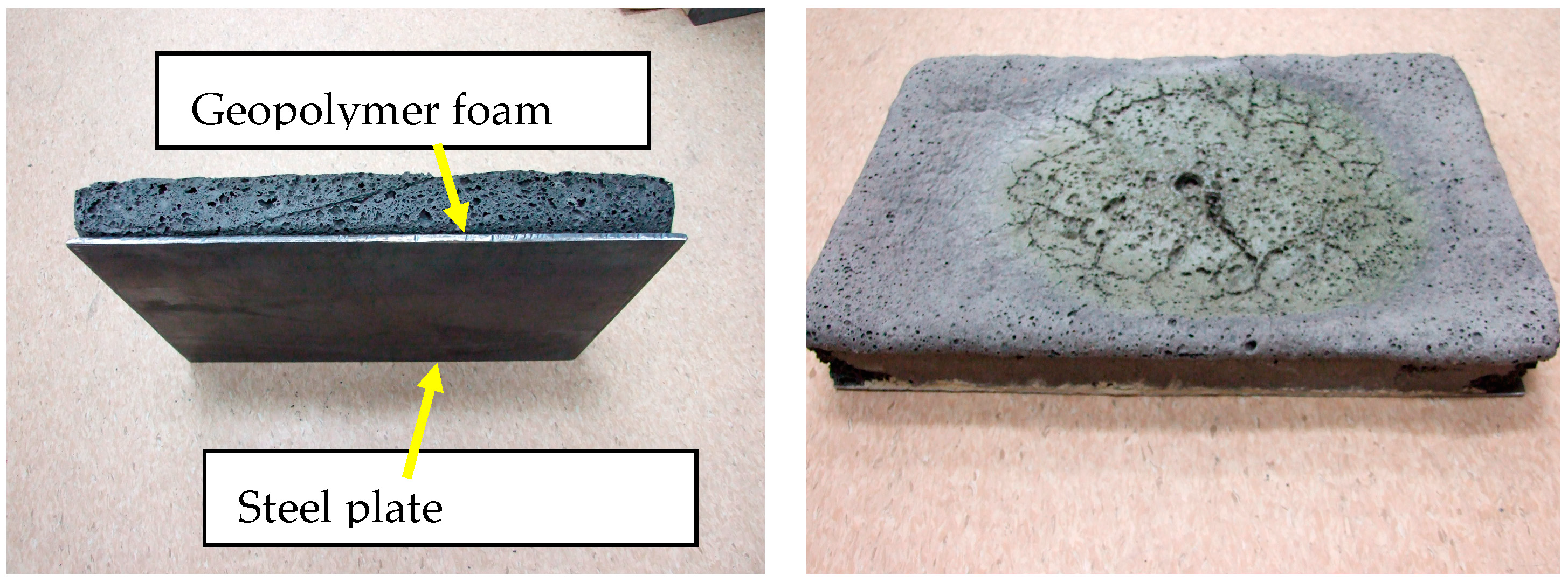


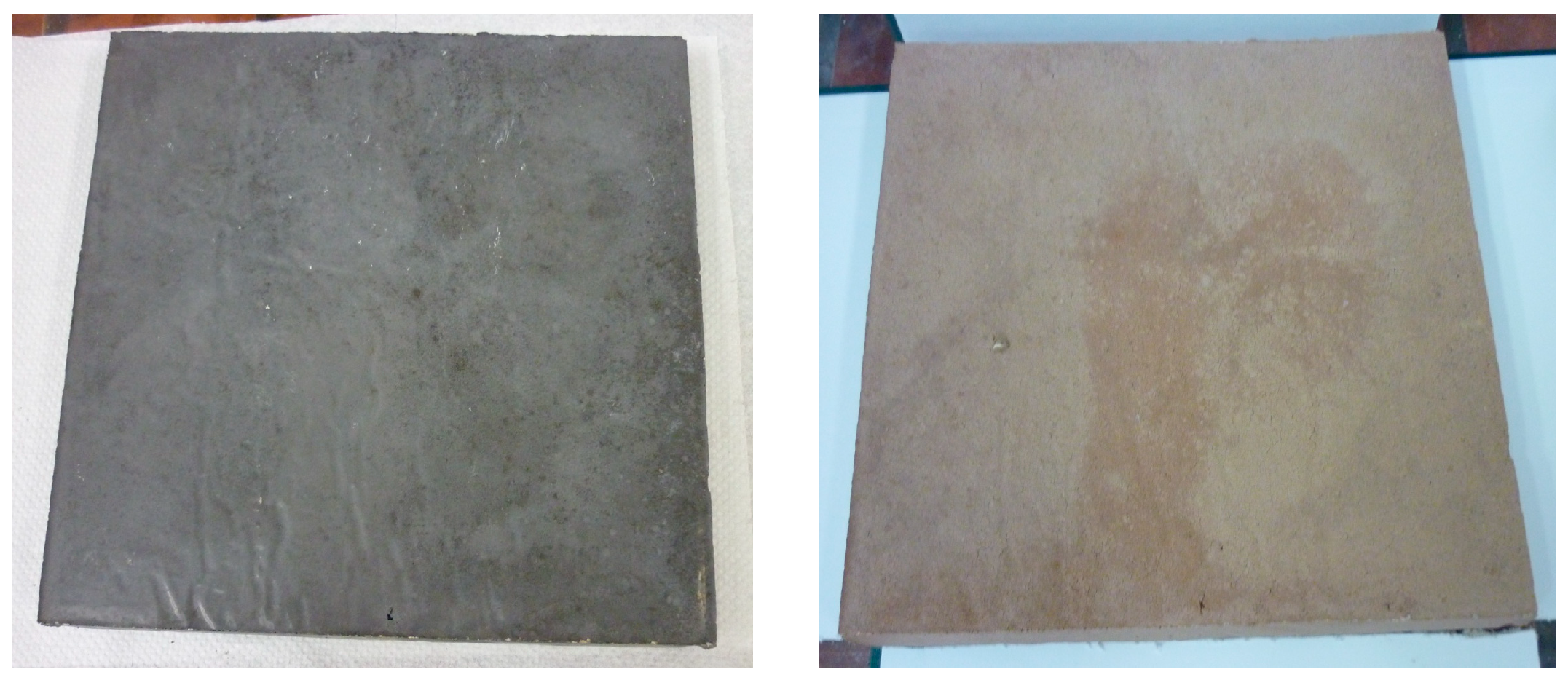

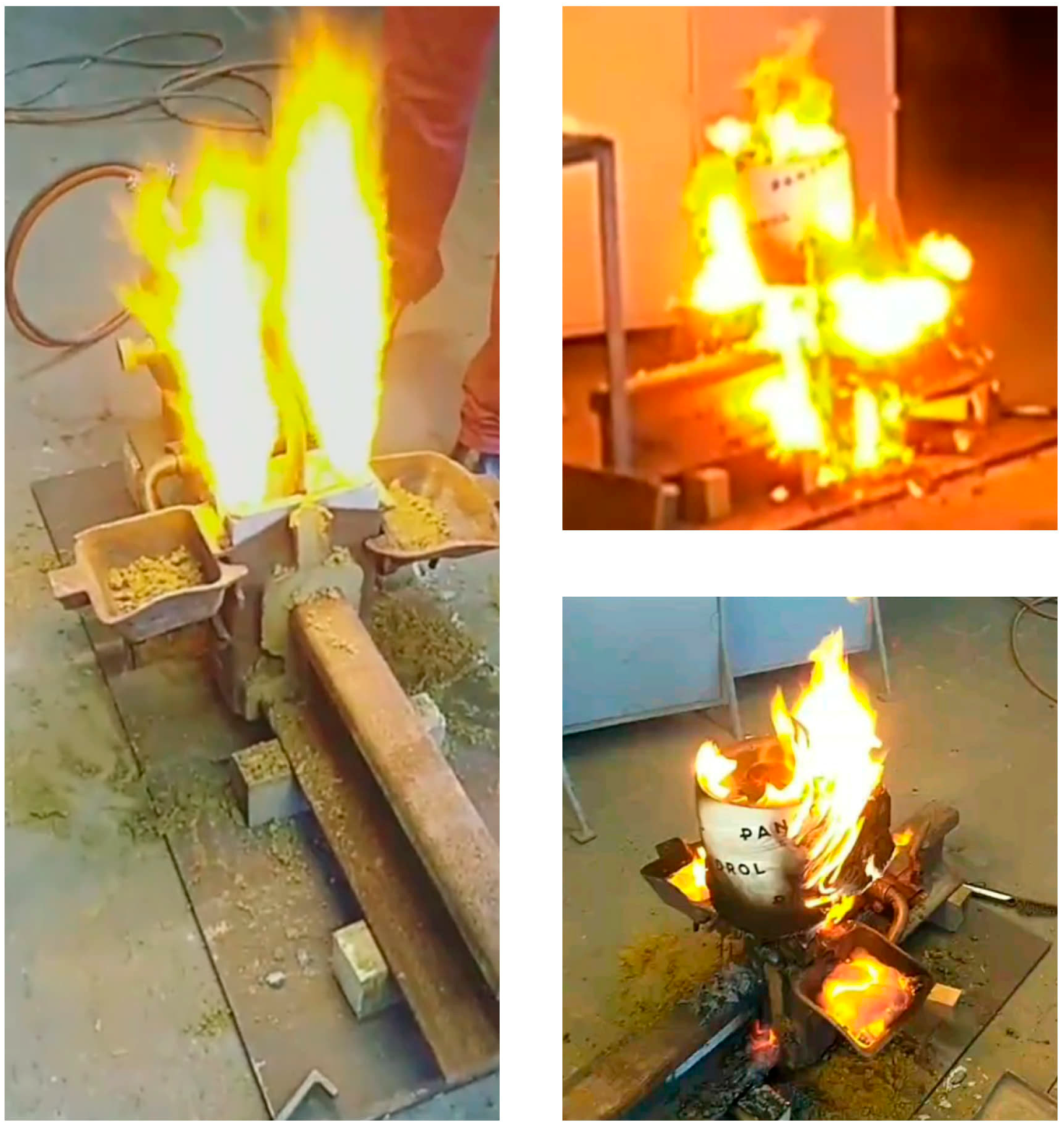
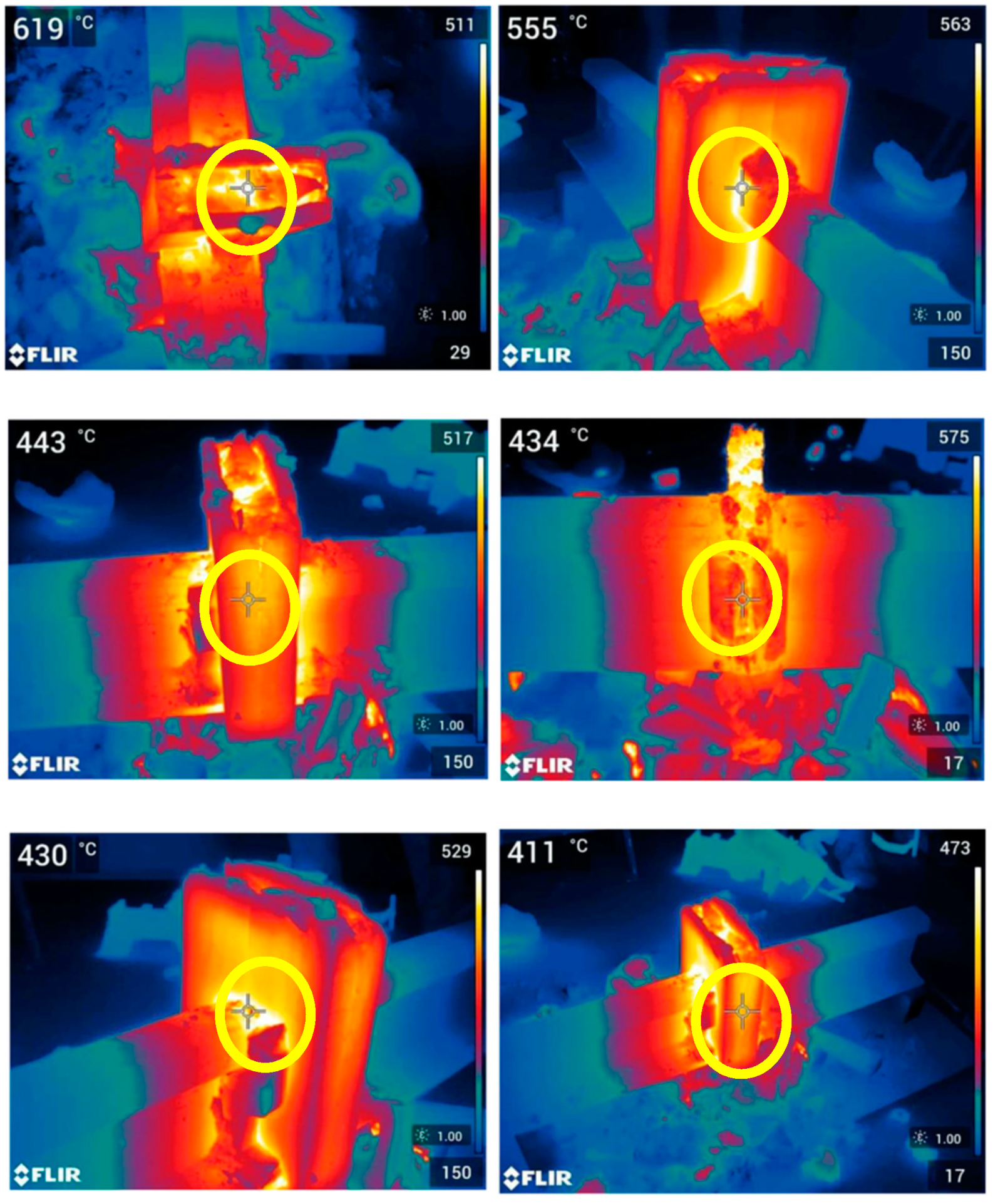

| Precursor | Oxide Composition (wt%) | |||||||
|---|---|---|---|---|---|---|---|---|
| SiO2 | TiO2 | Fe2O3 | Al2O3 | CaO | MgO | K2O | Na2O | |
| Fly ash | 55.9 | 1.09 | 5.92 | 23.49 | 2.72 | 2.61 | 3.55 | 0.59 |
| ID | Mean Temp. (°C) | Delta Temp. (K) | Thermal Conductivity (W/m × K) | U_TC (%) | Thermal Resistance (m2 × K/W) | U_TR (%) | Temp. Gradient (K/m) | Duration (hh:mm:ss) | Load Pressure (kPa) |
|---|---|---|---|---|---|---|---|---|---|
| 1 | 9.7 | 4.2 | 0.88978 | 1.9 | 0.0239 | 1.7 | 197.61 | 00:54:40 | 2.8 |
| ID | S (mm2) | F (kN) | Rm (MPa) |
|---|---|---|---|
| 1 | 2480.59 | 80.77 | 32.56 |
| 2582.16 | 86.11 | 33.35 | |
| 2559.24 | 84.17 | 32.89 | |
| 2466.80 | 76.86 | 31.16 |
| ID | S (mm2) | F (kN) | R (MPa) |
|---|---|---|---|
| 1 | 570.69 | 3.38 | 5.91 |
| 563.12 | 3.55 | 6.31 |
| Features Examined | Value |
|---|---|
| Heat of combustion (mJ/kg) | −0.44 |
| Sample weight before testing (g) | 98.34 |
| Sample weight after testing (g) | 93.45 |
| Weight loss (%) | 4.97 |
| Weight loss (g) | 4.89 |
| Duration of the test (s) | 1800 |
| Duration of flame combustion (s) | 0 |
| Initial furnace temperature (°C) | 751.00 |
| Final furnace temperature (°C) | 767.66 |
| Final surface temperature of the sample (°C) | 777.97 |
| Maximum furnace temperature (°C) | 768.31 |
| Maximum surface temperature of the sample (°C) | 778.65 |
| Furnace temperature increment ΔT (°C) | 0.66 |
| Increase in sample surface temperature ΔTs (°C) | 0.68 |
Disclaimer/Publisher’s Note: The statements, opinions and data contained in all publications are solely those of the individual author(s) and contributor(s) and not of MDPI and/or the editor(s). MDPI and/or the editor(s) disclaim responsibility for any injury to people or property resulting from any ideas, methods, instructions or products referred to in the content. |
© 2023 by the authors. Licensee MDPI, Basel, Switzerland. This article is an open access article distributed under the terms and conditions of the Creative Commons Attribution (CC BY) license (https://creativecommons.org/licenses/by/4.0/).
Share and Cite
Parzych, S.; Paszkowska, M.; Stanisz, D.; Bąk, A.; Łach, M. Possibilities of Using Geopolymers in Welding Processes and Protection against High Temperatures. Materials 2023, 16, 7035. https://doi.org/10.3390/ma16217035
Parzych S, Paszkowska M, Stanisz D, Bąk A, Łach M. Possibilities of Using Geopolymers in Welding Processes and Protection against High Temperatures. Materials. 2023; 16(21):7035. https://doi.org/10.3390/ma16217035
Chicago/Turabian StyleParzych, Sławomir, Maja Paszkowska, Dawid Stanisz, Agnieszka Bąk, and Michał Łach. 2023. "Possibilities of Using Geopolymers in Welding Processes and Protection against High Temperatures" Materials 16, no. 21: 7035. https://doi.org/10.3390/ma16217035






